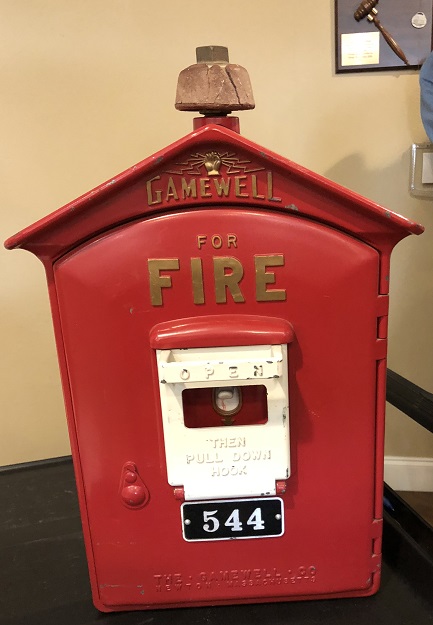Chief Dave Casey |
 | Fire alarm pull boxes like this one were installed in 1933 all over San Angelo on telephone poles.
When the handle was pulled, a ticker tape machine punched out 5 holes, 4 holes, and then 4 holes to identify the location.
This one was in the barero and was frequently pulled for fun. Dave bought this one for $300. In 1854, Bill Channing and MOses Farmer in Boston MA. applied for a patent for a "Electromagnetic Fire Alarm Telegraph for Cities" In the later years of their use and proliferation, some fire boxes were designed with special devices and other functions in place in an attempt to curb the nuisance of false alarms. Some of these included an "ear-shattering" wail that would cause discomfort (and possible hearing loss) to someone activating the box, while others would handcuff a detachable part of the device to the person triggering the alarm, so that responding police and fire officials (who possessed the key for release) could more easily identify and contact the individual responsible for the activated alarm |
When the Federal Government moved the national firefighting school to San Angelo (for the training of all military and civil service firefighters) the San Angelo Fire Dept. was about to take over all airport firefighting duties. We worked out a program with Goodfellow AFB to help train our airport firefighters, and we would help them with our training center in structural firefighting. In Dec 2000, Dave was approached by the Chief of the Fire Dept. about becoming the Safety Engineer. It was a very good increase in salary, and he would not have to pull shift work any longer. Hauling around 50 pounds of gear with an air pack in a smoky environment is a young man's job. To stay in shape, he and Lynn got up at 4 AM and ran 3 miles, five days a week. Dave explained that most firefighters are killed by structural collapse, so the safety engineer has to respond to all structure fires. He was responsible for investigating vehicle accidents for the dept. He had to keep up with everyone shots and specialized equipment, give monthly safety meeting to the troops, run the physical fitness program, keep the department's policy and procedures up-to-date with the changing laws from the state and federal government etc. Dave told of one incident that happened early one morning. One of the firefighter/paramedics was taken to the emergency room(ER) with blood exposure to the face. The firefighter/paramedic had responded to a gunshot victim and immediately started CPR. The paramedic had not checked the entrance or exit wound (the patient had been shot with a shot gun through the heart) nor did he have his protective eyewear on. When he compressed the chest, blood spurted into his face. The ER needed three vials of blood to check for AIDS and Hepatitis C, but the patient had already been sent to the morgue. Dave immediately went to the funeral home and contacted the mortician as they were about start the embalming procedure. To this day, every time Dave sees that firefighter/paramedic, the firefighter/paramedic is forever thankful and responds with "Wear Them Goggles."
